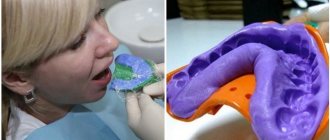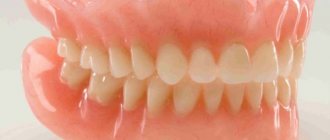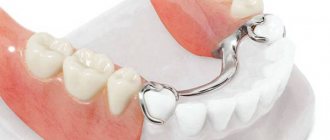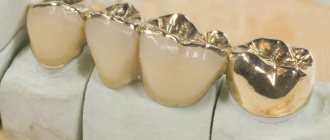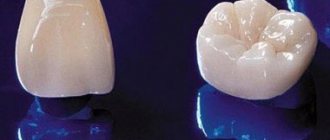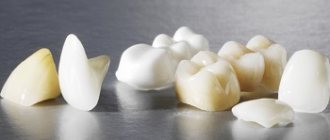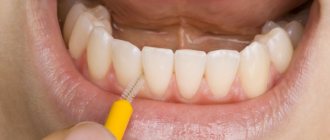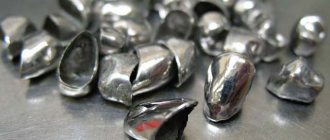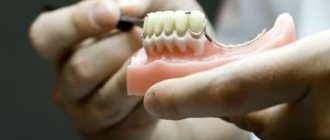Stages of manufacturing cermets
- The dentist prepares the working area in the patient's mouth for taking an impression. Destroyed tissues are removed. To increase the accuracy of the impression of irregularities, the teeth are slightly ground down. During the absence of permanent crowns, temporary crowns are installed in their place in order to hide tooth defects.
- An impression is made using a two-layer impression mass. The first layer of the impression is thicker to create a solid base for the thinner second layer. Two layers of different thicknesses provide greater accuracy to the impression. Depending on the technique, impressions are taken on the day of turning or on the next visit to the patient. To further increase the accuracy of reproducing all the details of the tooth, the gum is slightly shifted using retraction threads or rings.
- The impression is sent to a dental laboratory, where its quality is assessed by a specialist. A high-quality cast must meet certain parameters: good visibility of all folds, tubercles and strands of the mucous membrane, chewing surfaces, cutting edges and necks of teeth; absence of bubbles and areas blurred by saliva. If the cast passes the quality assessment, the production of a plaster collapsible model of the oral cavity begins, on which all technical work will be carried out.
Main types of prosthetic bridges
Dental bridges are quite varied, so you can choose the ideal option for yourself, both in terms of convenience and financial costs. All structures are classified according to the materials from which they are made, manufacturing technology and fixation.
Most often, the non-removable option is chosen; such devices are more convenient and reliable. Removable models of this type are installed only for people who have any contraindications. A special difference between such products is the method of fastening; they have double-arm support-retaining clasps.
Removable bridge with clasps
All dentures are divided according to the type of support, they can be:
- one-sided, which are intended to restore front teeth;
- bilateral;
- on implants;
- on locks.
Also, the device is selected taking into account the location of the intermediate part. There are tangents, they come into contact with the mucous membrane; this option is most often used if the anterior dental units are lost. Flushing devices are more convenient and easier to care for, since there is space between the gum and the denture. The saddle design is used quite rarely.
Adhesive prosthesis
This type of bridgework involves securing a fiberglass band between the abutment teeth on which the artificial teeth are placed. To fix the structure, small stepped indentations are made on it, and then it is glued with a special composite compound.
The characteristics of the dental appliance are as follows:
- It is used only if it is necessary to restore one dental unit.
- Instant production and installation, the result can be obtained in one visit to the dentist.
- The prosthesis is classified as a temporary option, so it is not recommended to use it for a long time.
- To install a prosthesis, you do not need to grind your teeth; the specialist prepares only the area of the defect, as well as the chewing surface.
Basically, such a dental device is installed for the period when the main dentures are being prepared. They are quite cheap, so they are used by many patients.
A very popular material that is most often used in prosthetics. A metal-ceramic bridge consists of a metal base covered with porcelain on top. The frame itself can be different: nickel, chrome, cobalt, palladium, gold.
The main characteristics of this design:
- strength and reliability;
- high aesthetic qualities;
- crowns practically do not wear off;
- most restoration work can be carried out in the oral cavity;
- ideal for restoring the front row of teeth;
- for installation it is necessary to remove and grind down the supporting teeth;
- the device can be made to replace four dental units at once.
Many patients prefer this type of prosthetics. This is due to the fact that such bridges are quite strong, closely resemble natural teeth, have a long service life and are affordable.
Other options
There are also ceramic bridges; they are more expensive than the previous type; with this design, no more than two teeth can be restored. They are often used to eliminate minor cosmetic defects. Such crowns are quite lightweight, securely fixed to the support, and it is almost impossible to recognize that these are artificial elements. It is also worth adding that the material does not lose its aesthetic characteristics throughout its entire service life.
Metal-free ceramics
The one-piece structure is cast from cobalt and chromium, leaving no seams. The surface can be simply metal, or it can have gold or plastic plating. Such bridges are very practical and durable due to the fact that they fit tightly to the support, but they have a significant drawback in the form of poor aesthetics, so they are practically not used for the restoration of anterior teeth.
Bridge prosthesis on implants
A bridge on implants can be disassembled, so if one of the crowns becomes unusable, it can always be replaced. Prosthetics are carried out by implanting a special metal rod into the gum, and a bridge-like prosthesis is attached to it.
Laboratory stages of manufacturing a metal-ceramic crown
- A dental laboratory specialist uses wax to model the frame of a future metal-ceramic bridge.
- The wax composition is sent to the foundry laboratory.
- The cast metal prototype is returned from the foundry and installed on the plaster model. In this condition, it is sent to the treating dentist for fitting in the patient’s mouth.
- During fitting, the color and degree of transparency of the future structure are determined.
- The metal frame is prepared for the application of a porcelain layer for better adhesion of the two materials. To do this, the frame is fired and sandblasted.
- The first layer of ceramic is applied - opaque porcelain. Then the procedure is repeated again. After this, the prosthesis is covered with a dentin layer, followed by an enamel layer. The aesthetic appearance of the prosthesis depends on the clear sequence of actions and the accuracy of the proportions of materials.
- The dentist examines the prosthesis and confirms its compliance with the real prototype. After this, the prosthesis is glazed and subjected to final firing, after which it is ready for installation.
Prosthetics of chewing and anterior teeth, nuances
If your chewing teeth have collapsed and you need dental prosthetics, metal ceramics are the best choice. It is almost invisible on the posterior parts of the jaw. Therefore, such defects as cyanosis of the gums or exposure of the metal edge remain invisible to outsiders. And the ceramic coating is enough so that the structures are not noticeable.
Plus, the load on the chewing teeth is large. Pressed ceramics, metal-plastic and zirconium dioxide with lining cannot withstand it. But cermets do the job easily.
It is not advisable to place metal-ceramic crowns on the front teeth. An exception is patients who need prosthetics for the entire frontal group of teeth on both jaws. Here the designs are more or less suitable.
Therefore, metal ceramics are almost never used on the front teeth. Frontal units are preferably treated with ceramic crowns - they perfectly imitate the translucency, color and exact shade of enamel.
Before and after
Service life of metal-ceramic prostheses
If the manufacturing and installation sequence is strictly followed, metal-ceramic crowns and bridges serve without loss of functionality and appearance for many years. The average service life of metal-ceramic crowns on a frame made of chromium and cobalt alloy is from 8 to 10 years. The use of titanium and gold alloys increases the service life to 15 and even 20 years.
Dental clinics provide a guarantee on metal-ceramic crowns for a period of 12 to 18 months. During this time, it is recommended to take x-rays of the teeth on which crowns were installed several times. In some cases, inflammatory processes do not make themselves felt for a very long time - the patient does not feel discomfort or pain. An x-ray will then help detect the problem before it becomes serious. The clinic that deals with prosthetics takes on the financial costs of treating the tooth and making new metal-ceramic crowns.
Metal-ceramic dentures do not look as natural as non-metal ones, but they are much stronger than them. At the same time, their appearance is much more natural than that of all-metal crowns. Thus, metal-ceramic crowns are the optimal solution for microprosthetics.
Indications and contraindications for installation
A fixed bridge consists of crowns that are placed on supports prepared in advance, and a separate part where artificial teeth are located. This type of prosthetics allows you to make your smile attractive, as well as restore chewing function, while maintaining sensitivity and taste.
The main indications include:
- missing one molar;
- the need to install one or several anterior dental units at once in the presence of lateral supports;
- extensive defects or anomalies that arose due to trauma or dental pathologies;
- replacing an old or broken structure.
In addition, prosthetics are often performed to eliminate any cosmetic defects. And also to restore important physiological functions of the jaw, such as chewing and speech.
The procedure also has contraindications, they are as follows:
- absence of a molar, two premolars, and four incisors in a row;
- for any inflammation in the oral cavity, you should first eliminate the problem and then proceed with prosthetics;
- periodontitis, especially the more complex form;
- bruxism;
- in case of an abnormal bite, it is initially necessary to correct the defect, and only then install a prosthesis;
- pathologies of a bone-jaw nature;
- increased abrasion of tooth enamel.
In addition, dental prosthetics with bridges should not be performed on people who have increased blood clotting, as well as those who are allergic to painkillers. Adaptations are also not provided for mental disorders.
Metal ceramics are installed when:
- destruction of crowns by 2/3 or more;
- fractures;
- pathological abrasion of enamel and dentin;
- slight curvature of the front teeth - sometimes bite defects are hidden under crowns, although most dentists do not recommend doing this;
- the absence of 1-2 teeth - in this case, a bridge is made.
Metal-ceramic crowns on the front teeth
It is prohibited to fix metal-ceramic dentures if:
- up to 21 years of age - before this period, the processes of formation of the dental arch and mineralization of teeth are still ongoing;
- end defects: the bridge cannot be fixed if the last tooth in the row is removed, installation of an implant - dental or basal - will help here;
- extended included defects - if 3 or more adjacent teeth are missing, it is better to install a removable denture;
- severe violations of occlusion - open, cross bite;
- allergies to metal alloys - this only applies to cobalt and nickel chromium, and titanium and gold do not cause hypersensitivity;
- severe osteoporosis;
- severe diseases of the central nervous system and mental disorders.
We invite you to familiarize yourself with Bottle caries causes of development stage treatment methods
Crowns are made from impressions.
In other situations, the disease is first eliminated or remission is achieved, and then prosthetics are provided.
Average prices in Moscow clinics
The range of prices for different types of metal-ceramic prostheses is enormous. The most budget designs start from 5,000 rubles per crown, and the most expensive ones reach prices of 40,000 rubles.
| Type of metal-ceramic crown | Price per unit of metal ceramics |
| made of cobalt-chromium alloy | 10,000 rub. |
| made of nickel-chromium alloy | 9,000 rub. |
| titanium | 20,000 rub. |
| with frame made of gold-palladium or gold-platinum alloy | 25,000 rub. |
| with shoulder mass | 13,000 rub. |
| milled using SAD/CAM technology | 18,000 rub. |
Prices are for turning, taking impressions, the prosthesis itself and its fixation. However, please note that there may be additional costs for:
- dental preparation – calculated individually for each patient;
- restoration of a unit with a pin – 1,500-2,000 rubles;
- restoration of the crown with a stump insert - 5-15 thousand rubles;
- closing the stump with a temporary plastic crown – 1,000-1,500 rubles.
